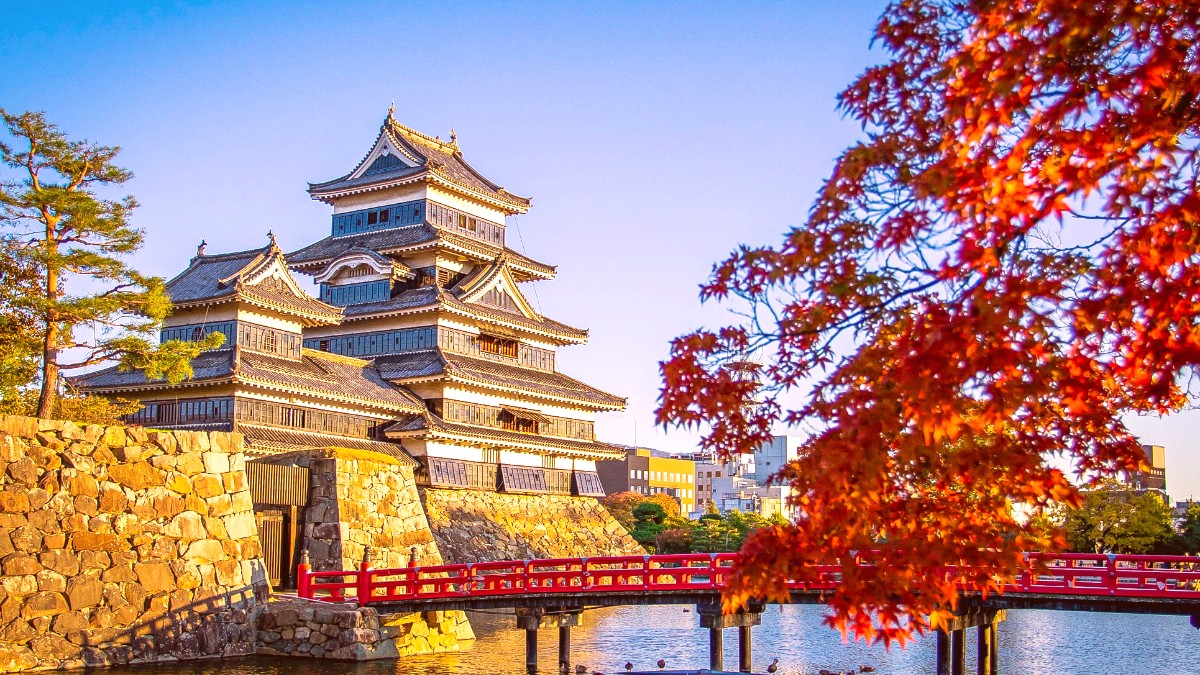
Central Honshu, Japan
Matsumoto's most recognizable sites include profound historical and cultural elements.
Matsumoto Castle, a National Treasure, dates to the early 17th century. Its distinctive black and white facade earned it the nickname "Crow Castle." As a flatland castle, its complex defensive structures and original wooden interior are notably noteworthy.
These sites collectively portray Matsumoto's rich heritage.
Distinctive white-walled kura architecture shows Matsumoto's merchant past.
Retains a traditional market feel, evoking its historical role as a lively hub.
Features the former Matsumoto High School building, a beautiful Western-style building from the Taisho period.
A Shinto shrine at the end of Nawate-dori, popular for blessings.
A Zen temple known for its tranquil rock garden.
Matsumoto's location near the Japanese Alps presents natural beauty, from city parks to expansive highland plateaus.
Extensive grounds with a moat, gardens, and seasonal flower displays. Ideal for leisurely walks.
Spacious urban park with a large pond and walking paths. Popular for relaxation and picnics.
On a hill overlooking Matsumoto, with panoramic views of the city and Japanese Alps. Features a zoo and walking trails.
A highland plateau offering spectacular panoramic views of the Japanese Alps and an outdoor art museum. A recommended day trip.
Known as the "Japanese Yosemite," a pristine alpine valley in the Northern Alps with breathtaking scenery. Consider a Hiking guidebook for the Japanese Alps (affiliate link).
Wild animals like Japanese macaques and serows can be spotted in remote mountainous areas like Chubu Sangaku National Park.
Alps Park Observation Deck: Outstanding vantage points for city and Northern Alps views, especially at sunset.
The Japanese Alps themselves, with dramatic peaks, deep valleys, and volcanic formations. These mountains comprise incredible landscapes.
Metoba River: A small river through Matsumoto, bordering Nawate-dori. Lake Suwa (day trip): A scenic freshwater lake south of Matsumoto, with hot springs and boat tours.
Beyond the main circuit, Matsumoto conceals several lesser-known attractions and local favorites. These sites present unique experiences and distinct perspectives on the city.
Matsumoto's charm extends to its local favorites, rarely visited by tourists, and offers unique photo opportunities for capturing the city's essence.
Azaido-yokocho: A small, atmospheric alleyway near the castle, home to traditional eateries and bars. This presents an authentic local dining experience away from tourist-centric areas. Matsumoto Citizen's Market (Matsumoto Shimin Ichiba): A lively local market for fresh produce and seafood, showing a genuine slice of local culture.
Nearby hot spring towns offer quieter, authentic ryokan and onsen experiences, providing a relaxing escape and a connection to local traditions, away from main tourist crowds.
Capture Matsumoto's beauty at these iconic and scenic spots.
Discover the breadth of Matsumoto's cultural landscape through its specialized museums and galleries.
Matsumoto's history comprises more than its castle, with sites and districts that portray its past.
Optimize your sightseeing with these practical suggestions.
Group nearby attractions to minimize travel time. The castle, Nakamachi, and Nawate areas are highly walkable.
Visit popular sites like Matsumoto Castle early in the morning to avoid crowds.
The Matsumoto Tourist Information Center offers maps, brochures, and current event schedules.
Check local Matsumoto tourism websites for seasonal food festivals, agricultural fairs, or sake tasting events. These present unique local experiences.
Consider day trips to Kamikochi for stunning alpine scenery or Utsukushigahara Kogen for panoramic views and an outdoor art museum.
Participate in soba-making classes or sake brewery tours to deepen your cultural immersion.
Matsumoto's flat city center makes it ideal for exploring attractions on two wheels. Bicycle rentals are widely available.
Visit nearby onsen towns like Asama Onsen for a relaxing and authentic hot spring experience after a day of sightseeing.
Explore the unique collections housed in Matsumoto's various museums.
Explore the city's past by visiting sites and districts that portray its historical development.
Matsumoto's well-preserved historical sites and cultural institutions offer deep insights into Japan's heritage.
Utilize the Town Sneaker bus for convenient access to many attractions within the city center.
Matsumoto's proximity to the Japanese Alps makes it a prime location for outdoor enthusiasts and those seeking relaxation.
The city's green spaces and nearby natural wonders provide tranquil escapes and stunning vistas.
Discover breathtaking landscapes and serene waterways surrounding Matsumoto.
Explore varied terrain from easy walks to challenging mountain treks, and look for local wildlife.
Always check trail conditions and weather forecasts. A Deuter Speed Lite 20 Hiking Pack (affiliate link) or similar gear is advised for day trips.
Matsumoto's location presents opportunities for high-adrenaline activities.
Water sports are limited within the city. Check for rafting or canyoning in wider Nagano Prefecture during warmer months.
Explore the city and its surroundings on two wheels, then unwind in local hot springs.
Always follow onsen etiquette, including washing thoroughly before entering and no swimsuits. Tattoos may be an issue.
Matsumoto is not a prominent center for retreats. Some guesthouses in wider Nagano Prefecture might present these programs.
Some traditional Japanese massage (shiatsu) or acupuncture clinics may exist, but often cater to locals, and Japanese language skills may be needed.
Beach and pool clubs are not applicable in landlocked Matsumoto. Focus on river and lake activities where available.